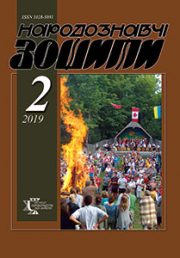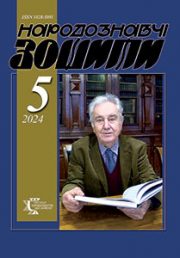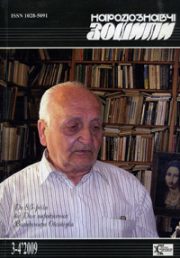The Ethnology Notebooks. 2024. № 1 (175), 154—158
UDK 745.51:008(477.83/.86)
DOI https://doi.org/10.15407/nz2024.01.154
ODREKHIVSKYI Roman
- ORCID ID: https://orcid.org/0000-0003-3581-4103
- Dr. hab. in Art Studies, Professor,
- Ivan Boberskyi Lviv State University of Physical Culture, Lviv,
- Professor of the Departament of Choreography and Art History,
- 11, Kostyushka Str., 79007, Lviv, Ukraine,
- Contacts: e-mail: odre2010@ukr.net
Abstract. Introduction. Galicia is the region of artistic traditions of the Ukrainian people, which led to the flourishing of the national style in art. The article analyzes the development of art in Galicia in the first third of the 20th century.
Problem Statement. At the beginning of the 20th century, while the Galicia region was under Austrian-Hungarian rule, there was a national revival of Ukrainians living there. In the 1920s and 1930s, the further process of development of Ukrainian art continued during the stay of Galicia as part of the Second Polish-Lithuanian Commonwealth.
Purpose. To show the social and economic conditions of the development of art in Galicia in the first third of the 20th century as a special period in the history of Ukrainian art.
Methods of the research are based on general scientific principles: systematicity, reliability, historicism, logic. Comparative-historical and cultural methods are dominant for analyzing socio-cultural processes and the development of art in Galicia in the first third of the 20th century.
Results. One should remark a rise in the development of art in Galicia at the beginning of the 20th century. Ukrainian emigrants from the American continent made a significant contribution to the financing of culture and art in Galicia during this period. A number of art schools were opened to teach plastic arts, architecture, choreography and other arts. Special attention was paid to the development and promotion of Ukrainian artistic traditions, in particular, in artistic and pedagogical activities in carving, weaving, choreographic and other art schools.
Conclusion. In the first third of the 20th century, art in Galicia was in special social and economic conditions of development. This is the period of Ukrainian natural revival, which developed under the influence of own centuries-old traditions, as well as with the financial support of the Greek Catholic Church and Ukrainian organizations in Galicia and on the American continent. Thanks to that there was a rise and flourishing in the development of art.
Keyworlds: Galicia,art development, choreography, principles of dancing, fine arts culture, carving, arts school.
Received 15.12.2023
REFERENCES
- Doroshenko, D. (1991). Essay on the history of Ukraine: in 2 vol. (Vol. 2). Kyiv: Globus [in Ukrainian].
- Kryp’iakevych, I. (1990). History of Ukraine. Lviv: Svit [in Ukrainian].
- Noha, O. (1999). Ukrainian style in the church art of Galicia of the late 19th and early 20th centuries. Lviv: Ukrainian Technologies [in Ukrainian].
- Noha, O., & Yatsiv, R. (1998). Art societies, associations, groups, unions of Lviv (1860—1998): Materials for the directory. Lviv: Ukrainian Technologies [in Ukrainian].
- Odrekhivskyi, R. (2023). Art as an artistic and aesthetic phenomenon of the sacred culture of ukrainians in Galicia. The Ethnology notebooks, 2 (170), 379—385. DOI https://doi.org/10.15407/nz2023.02.379 [in Ukrainian].
- Subtel’nyj, O. (1991). Ukraine: history. Kyiv: Lybid [in Ukrainian].
- Shmahalo, R. (2005). Art education in Ukraine in the mid-19th — mid-20th centuries: structuring, methodology, artistic positions. Lviv: Ukrainian Technologies [in Ukrainian].
- Shabalina, O. (2016). Development of Ukrainian choreographic art at the beginning of the 20th century: sources and trends. Bulletin of the Lviv National Academy of Arts (Issue 28, pp. 263—273) [in Ukrainian].
- Kvas, O., & Marushka, M. (2021). Education of children and youth of Ukrainian folk dances in Galicia (1919—1939). Bulletin of Lviv University. Pedagogical series (Issue 35, pp. 102—109) [in Ukrainian].
- Struminsky, B. (Ed.). (1988). Lemkivshchyna: Land. People. History. Culture: in 2 vol. Notes of the Scientific Society named after Shevchenko. New York; Paris; Sydney; Toronto: Issued at the expense and measures of the Defense Organization of Lemkivshchyna in USA. First Department in New York [in Ukrainian].
- Kubiyovych, V. (Ed.). (1993—2003). Encyclopedia of Ukrainian studies: dictionary part: in 11 vol. Revision. in Ukraine. Lviv [in Ukrainian].
- Tarnovich, Yu. (1941). Lemkivshchyna. Material culture. Krakіv: Ukrainian Publishing House [in Ukrainian].







